#sigils in other alphabets
Photo



✨ HAPPY BDAY ✨ @trashbinwonderland here is your ART of your arthritic singblader wizgay blade runner gee whiz guy man boy dude
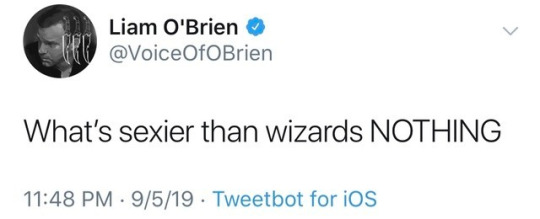
anyway hope u like it i hope u have a nice day i hope we have a nice day on saturday i hope we see hugo 💞
#i know im not really privy to his doing and whatevers going on in ebärrön but thankfully there was a lovely commission to refer to#i dont have to stealthily prod you for references this time#dnds ur big thing rn and it felt appropriate teehee#i dont even know if he uses fire spells. but whats a wizard without a fireball#i don't know what a balde--- sorry bladesinger even does#and i'm probably better off not knowing anyways#other ppls ocs#the rare occasion i like the lineart enough to not turn it into a painting lmao#but you gotta admit that foreshortening's pretty slick like for once it works#thank u free posing dolls on the webs#and thank me for learning a runic alphabet in like 5th grade for no reason for book and sigil decorating purposes#its all actual english text and its complete nonsense lmao#anywayyyy i love youuuuuu i hope you like iiiiiiiiit
3 notes
·
View notes
Note
sorry if this has been asked before, tumblr search is horrendous, do you have any visuals on the runes used by hunters?
not reaaally.... i've only ever drawn the ones on Lea's hands:


and i didn't really assign meaning to any of the symbols specifically, though i have tried to keep the shapes consistent whenever i draw them.
when i designed them i kinda based them off a combination of the runic alphabet, old alchemical symbols, and the very basic elemental symbols, which is why they're so angular:

with alchemy, the four base elements are the foundation of almost every transmutation, whether they're combining with each other or turning gaseous/solidifying/liquifying, etc. and magic is drawn from these four elements as well, with most people specializing in one or two elements. these systems are very tightly intertwined in the tnp world, and share a "language" so the sigils will look similar whether we're talking magic or alchemy (though magic isn't an exact science in the way that alchemy is, so runes aren't required in the same way, but rather used as an anchor/powered core for focused magic.) metal transmutations will use earth and fire, ice uses water and air, electricity uses air and fire, on and on and they just build on each other like a chemical equation, depending on the complexity of what's being done.
Lea and the hunter, as well as other members of the order (and people like Keres), are skilled enough in alchemy to not require drawing a full sigil, though the hunter does currently do this in the wraith fight since i wrote it before i tweaked some of the magic/alchemy system. the hunter themself will always have the basic sigils on their bracers, but an alchemist hunter will have more complex engravings as well as tattoos like Lea (if chosen by the player) and runes on their weapons, allowing them to transmute them (like the gauntlet or whip in the Duncan fight and the morningstar with the wraith.)
common alchemists, who are more like scientists than fighters like Lea and the hunter, will draw full sigils both for transmutations and while concocting potions.
i got a lot of inspiration from fullmetal alchemist, which does use classic 17th century alchemical symbols and imagery; the idea of the circle is the same in tnp, which is why Lea has those bands tattooed around their wrists. it allows them to use themselves/their hands as the foundational circle, rather than drawing it out, allowing for quicker transmutations.

#alchemical symbols have a lot of variety tbh#my only advice is to always double check designs since the runic alphabet has been coopted by white supremacists#unfortunately......#also sorry to use the lea strap picture up there its the only one i have that really shows their hands LOL#ask#anonymous#lore
45 notes
·
View notes
Text
Sigil Making
This is an overview of making your own sigils - what sigils are, what they are used for, how to charge them, and several of the more popular methods of making them! I’ll put a page break here for anyone not interested, as I expect this post to get longer than I intend rather quickly.
What Are Sigils?
Sigils are symbols of power and intent. They can look like almost anything, and there are a wide variety of ways people have developed to make them. We have evidence of them being used since the Stone Age, and have been used to direct power or interact with various beings/entities.
What Are They Used For?
The short answer? Anything. Because sigils are so personalized, there really is no real limit to what they can be used for once you know what you are doing. They can be incorporated into food, into drawings, into talismans and amulets, into tattoos, you name it. They can also be as simple or complex as you would like to make them.
How to Charge a Sigil
To charge a sigil means you are putting energy into it. That energy can come from a wide variety of places - especially if you are basing the source on what the final goal of the sigil is. For example, a sigil for healing might incorporate drawing energy from the earth or natural things, while a sigil for lucid dreaming might be charged with moonlight. You can even charge it with your own personal energy as well. Here is a good post explaining the process in more detail, as well as more of the sources of energy you can choose to use.
Making Sigils
Here I’ll be explaining a few of the more common examples of ways people make sigils. This is not an exhaustive list either - if none of them feel right, you can make a sigil differently, and if you do one of these methods in a different way, that is perfectly fine as well! This is just meant to be a guide to starting out.
Starting Out
Generally, you start with a word or phrase you would like to charge, such as “I am confident” or “Happiness”. From here, preference differs. Some people take out all the vowels first, others take out only repeating letters, others use all the letters, while some use only unrepeated consonants. Here is an example of what that process can look like from (surprisingly!) WikiHow:
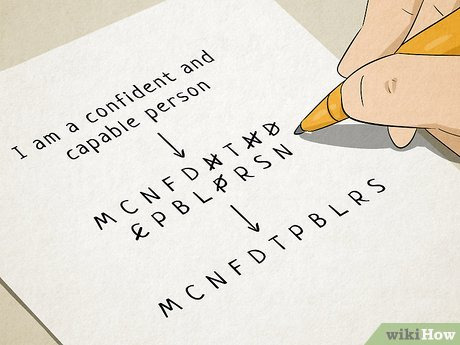
Once you have your letters or phrase down, it is time to pick a method for making the sigil.
Methods
Alphabet Wheel
In this one, you take the alphabet of whatever language you are using and put it into a wheel. Depending on how many letters you have, the wheel might look different, but here is an example of one using the Latin alphabet - specifically English:

To use this method, you would list out the letters of whatever word you want to spell and draw lines between them. In the example above, to make a sigil for ‘Joy’, they started at the beginning with a circle on J, drew a line to O, then drew a line to Y to end with a dash there. The circle and dash are not required, and some use other symbols instead of those for the start and stop, but that is the general method of using the alphabet wheel.
Number Wheel
Another method is by using a wheel of numbers. In this method, each letter in the alphabet is assigned a number - usually either 0-9 or 1-9, like this:

From there, you would number the outside of a circle with whichever range of numbers you used and connect your series of letters or phrase the same way as the alphabet wheel, like this:

Here is the link to the page I borrowed these images from, and here is a link to a more decorative style as well, using a different number range.
Word Shapes
This method is fairly straightforward, and there are two main design choices generally used with this method. Either you take the letters you’ve chosen as they are to make a design, or you break the letters you are using into their basic shapes to make the design out of those instead. Here are examples of what both can look like:

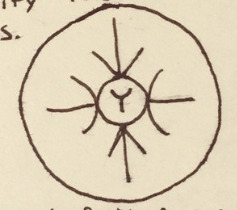
Here is the link to the full image of the first, and a post for the second method that I got the image from, that goes into a little more detail too!
Planetary Squares
This method takes some more work than the others, as it incorporates the planets and some more complicated number working, but it’s personally one of my favorites. If you want to use planetary correspondences with your sigils, then you use the planetary square for whichever one you choose. Here’s an example of the simplest one:

From there, you number your letters appropriately like this:

If any of the numbers go beyond the numbers available in the squares, then you remove a zero until they are no longer too large of a number. For example, in this case if I had a T in the square shown above that only goes up to 9, then I would take the 200 and turn it into a 2, which now fits.
When it comes to the number sequence from this, I’ve seen three methods of moving forward: using all the numbers you have to draw the sigil, taking out repeating numbers then drawing the sigil, or combining numbers differently to find the right shape for the sigil. For example, with the third one, if you end up with a sequence of 35201, depending on the size of your square you could read that as 3, 5, 20, 1 or 35, 20, 1. Picking the right one would be up to you.
Here is a post that I highly recommend describing the process in more detail, and a link to a site that has most of the planetary squares last I checked.
Drawings
The last method I’ll list here is both the simplest and most intuitive. Because sigils can look like anything, freehand drawing or drawings of an actual thing can also serve as sigils! Intuitive doodling can lead you to the correct shape if you’re in touch with your intuition enough, and as a witch friend once told me, “if you want happy plants and can charge a picture of a plant with a smiley face on it as a sigil, then use it!”. There are no limits here.
Conclusion
There are many ways to make sigils and sigils are fairly simple at their core. Of course, there are plenty of other methods of making them that I did not cover here, and certain traditions/histories have specific sigils linked to specific things or beings. But, in general, they are easy to personalize, very versatile, and there is no real limit to what you can do with them!
83 notes
·
View notes
Text
Unreliable Narrators

If you've watched Good Omens, there's a reasonably good chance you've got several conspiracy boards tucked somewhere in your brainspace. And what's great about a show like Good Omens is that we've been encouraged by the creators to poke our noses in deep and examine our theories. Even the show itself subtly tells us, "things are not what they seem." For evidence, might I call upon the book, The Crow Road, which appears several times throughout Season 2--notably when Jimbriel is alphabetizing books in his own special way and again when Muriel shows the Metabitch what they're reading. The Crow Road is a very specific *CLUE* because the book is written non-linearly and the reader must piece the story together. Sound familiar? You betcha.
Now I know a lot of us, myself included, are pretty invested in the time layers/time skips that may explain some of the incongruities of Season 2. (Crowley, I spent 90 minutes cataloging your ding dang sideburn length, sunglass style, shirt selection, and sigil placement. Short or long, dude! Sideburns don't grow down your face in the time it takes to walk outside.) But right now, I'm much more focused on the theory of the unreliable narrator.
So let's begin not at the Beginning, but in a graveyard in Edinburgh. Spooky. (I like spooky.) Let's talk about the uncanny Gabriel statue.
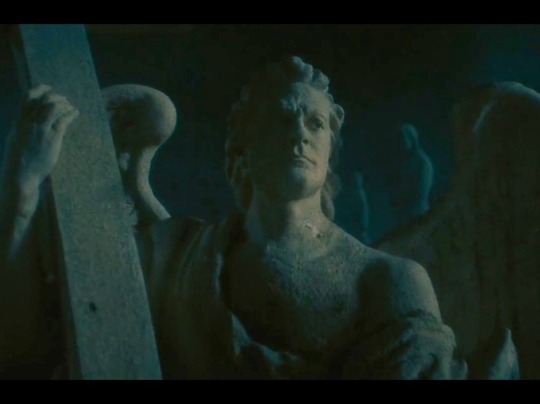
Crowley and Aziraphale are surprised by its accuracy. It's surprising enough that Crowley actually invites Aziraphale to come up to Edinburgh to see something that might amuse him. This suggests that MOST depictions of Gabriel that they've seen are not accurate. The essence of Gabriel is rarely manifest in the art created about him. What does this say about sculptors? Artists? About writers? About people who set out to tell a story and show a truth? That they're unreliable at best, only being able to show the version of events or subjects that they've seen, and furthermore only able to demonstrate these events or subjects to the best of their ability.
In other words, all art is unreliable narration.
Let's take a detour to another flashback to an earlier time. 2500 BC to be precise. We find ourselves in a memory of the story of Job, and in the recollection we meet a luxuriously goateed Crowley with a mane of flowing auburn hair. But this set of memories gets really screwy upon closer inspection, when you realize that Crowley's hair is markedly different at different points in the flashback. There are two distinct hairstyles, and it's up to us to figure out why!

Now, there's only one scene in which only one of our dynamic duo appears, the scene in which Sitis identifies Crowley as Bildad the Shuhite. In this scene, which we have to assume is from Crowley's memory, Crowley's hair is shoulder length and wavy. Going forward, this hairstyle will denote Crowley's perspective, and it is the hair style that Crow-dad (Crow-daddy? Grazie, lo detesto) wears for the majority of the Job flashbacks. So despite the fact that we enter these flashbacks through Aziraphale's musings in the bookshop, I have to argue that they're mostly from Crowley's perspective. However, when we get the giant camera shift from the Crow-dad/Sitis scene to the scenes that take place with Job's children, we also get a new hairstyle for Crowley. In this block of memories, Crowley's hair becomes significantly longer and also distinctly curly.
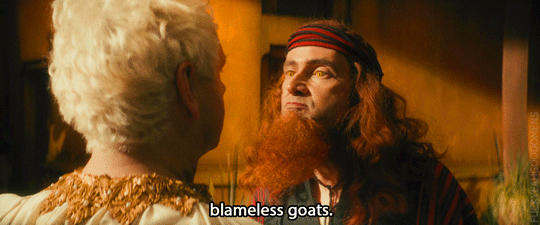
This is a different set of memories, and I think we have to assume that we're now seeing these memories from Aziraphale's perspective. This makes sense, because these memories are dealing with Aziraphale discovering more about who Crowley is (a demon who would disguise goats as crows to save them from God's gamble) and about who he (Aziraphale) is going to become (an angel who goes along with Heaven as far as he can.)
What this all tells us is that the narrative will be different depending on who is relating it. Crowley remembers his hair looking one way, Aziraphale remembers it looking another. We're all pretty unreliable narrators, since we can only express what we have seen or experienced from our own limited perspective and to the best of our ability. Everything we experience is filtered through the lens of our understanding. Even something as objective as an un-retouched photo frames the "truth" as the photographer sees it.

So for me, rather than seeing the indulgent use of clocks as a motif for dysregulated time, I'm choosing (for like this week, at least) to see time as a guardian. The use of clocks does more than demonstrate inconsistencies in time, it also gives us an objective framework from which to hang our unreliable narrations. Because Crowley's sideburns can't grow that quickly! But if we untangle time to reveal a linear flow, I think we'll see that it's the perspective or the narration that's shifted rather than the timestamp. I think that when all is revealed, it will be clear that our belief about what is true can be in direct opposition to another person's equally unreliable narration. Guess we'll just have to wait and see.
38 notes
·
View notes
Text
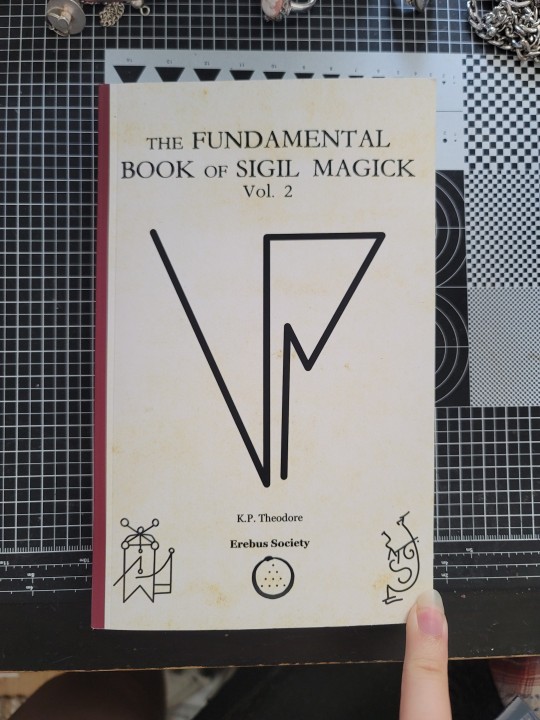
Okay so there is a book two of the sigil magic guide by K. P. Theodore and girl. GIRL! The other book didn't have any bullshit in it, and if you would like my quick thoughts on it check out this post, but this one introduces some bullshit.
Okay so the first two parts about what kind of sigils are there and how to make them is just the repetition of book 1 minus the pictorial method. That is fine besides this ugly ass sigil. Like girl i know you can use Adobe Illustrator way better than that cmon!
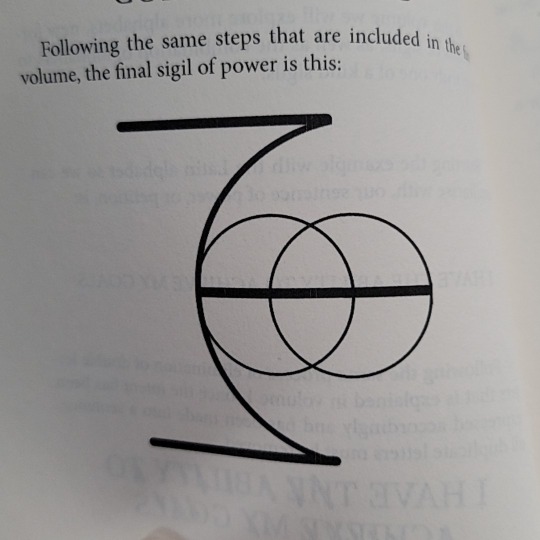
But anyways, here comes the bullshit. What isn't bullshit is the idea of using other scripts and languages other than English to make sigils. That is fine and if anyone figured out how to make sigils with a logographic or syllabic languages good for you and you can go ahead and use that.
Also this magi alphabet is fine it's just uh it's an occult way of writing Hebrew so that's iffy and idk if Theodore is Jewish. If this is your culture you're fine using this but still 💅

Here comes the bullshit:

This is NOT the enochian alphabet. THIS is the enochian alphabet

Then what is that alphabet then? The theban alphabet. What is the theban alphabet then in the book?
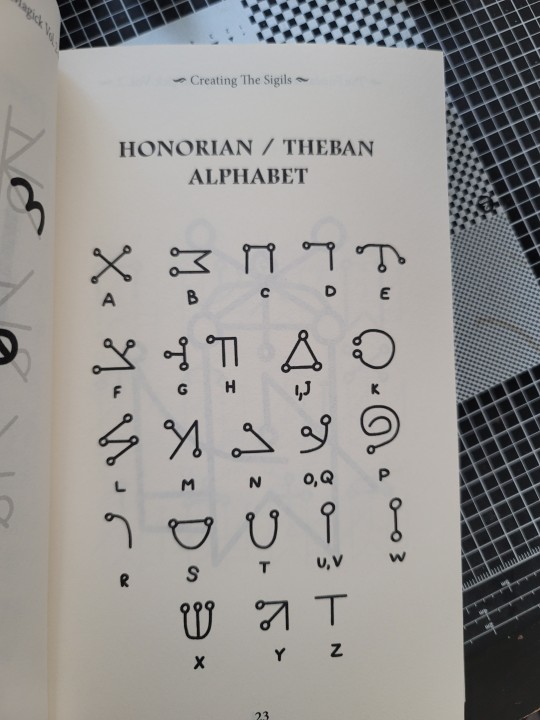
THIS IS NOT THEBAN. THIS IS CELESTIAL! oh boy then what is celestial???
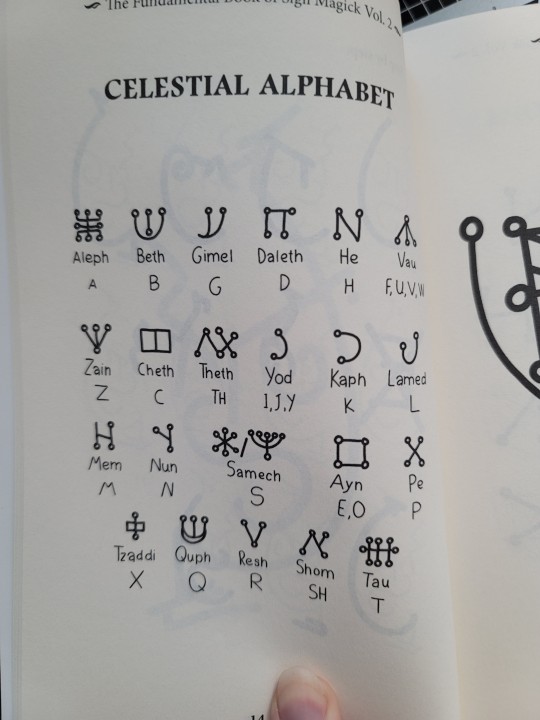
Do not let your eyes deceive you! This is not the celestial alphabet, this is the malachim alphabet. Both celestial and malachim are both a way of writing Hebrew for occult workings and I get it Theodore they look so similar! BUT YOURE AN OCCULT BOOK WRITER! YOU NEED TO GET THIS SHIT RIGHT! And by the way uh wanna know what the malachim alphabet is??? Before I start going insane???

Wh-WHAT IS THAT??? HUH??? WHERE ARE YOU GETTING YOUR SOURCES FROM THEODORE BECAUSE I CAN JUST FUCKING GOOGLE THIS SHIT TO FACT CHECK! I AM GOING TO BUY THAT OCCULT BOOK THAT YOURE APPARENTLY REFERENCING BUT FAILING TO EVEN REALLY READ IT!
Which is this
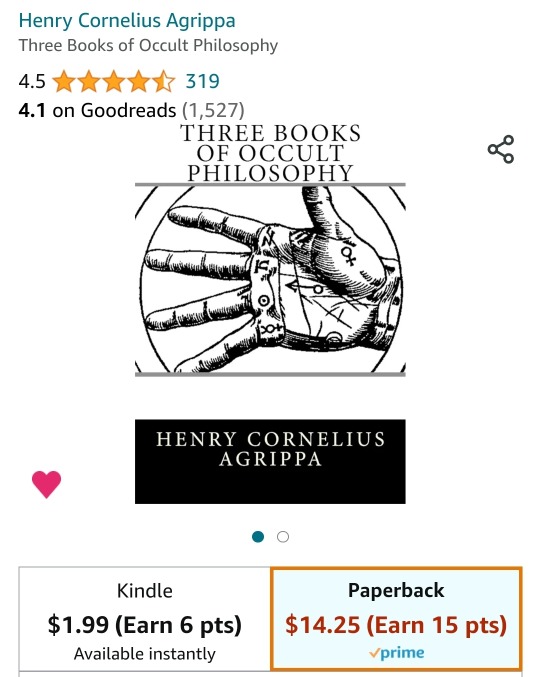
But it doesn't stop there. Oh no no no no! The bullshit hasn't stopped! It only begun! AND IVE RUN OUT OF HOW MANY PICTURES I CAN UPLOAD ON A POST VIA THE APP SO THIS IS GOING TO BE A THREAD!
please check the notes for the continuation of the bullisht
31 notes
·
View notes
Text
Number, Paths, & Sigils
Arithmology relates the emergence of patterns in numbers to the emergence of patterns in existence, making number a fundamental tool for the generation of meaning. In the system of the C-ov-N the counting numbers are core to the structure of its theories and metaphors.
A key break with other arithmological systems is to reject the base-10 counting system we are familiar with. The patterns within number exist independent of the base. Indeed, the base of the number system can be distracting from spotting the deeper patterns. For example, eleven, 11, is not meaningfully related to 2 even though it is the sum 1+1. This common pattern of summing the digits used in numerology is mathematical gibberish. Some mathematically interesting properties of eleven is that it is a prime number following the product of 2 and 5. It is next prime number after 7 and a member of the prime pair of eleven and thirteen.
A numerical place system and base is obviously useful for representing large numbers, but we find more utility to meditate on the meanings of smaller numbers by use of glyphs constructed in a manner that reflects the nature of the number. C-ov-N uses two systems of numeric sigils. One set is based on the factorization of the number and the other is a binary representation. The first is used for the number in itself and the second is to emphasize the number as sequence. The sigils stop at 31, though this is somewhat, though not entirely, arbitrary. It corresponds roughly to the number of letters and sounds represented in alphabets and days in a lunar cycle. It also allows the sigils to be useful without being overwhelming while the sigils themselves remain simple enough to read and write.
A table of the numbers and their associations:

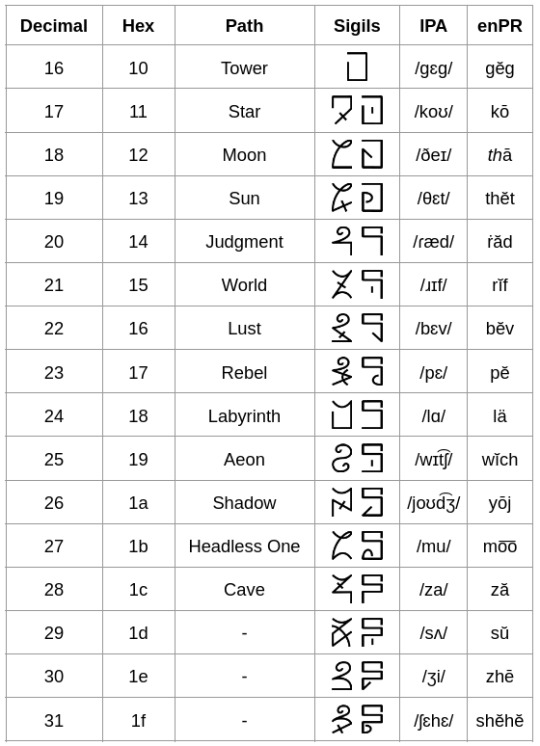
11 notes
·
View notes
Text
Common Terms and Meanings in Witchcraft
Here is a little dictionary of various witchy and magickal terms to help you guys out! I’ll try to keep it updated when I find new info
Altar: a place to do and practise Magickal things like spells and rituals or meditation. Also used for inspiration and honouring the deceased
Athame: a ceremonial blade used in ritual practices, not necessarily used to cut things or to draw blood.
Astral projection: projecting your spirit out of your body in order to be somewhere else. Often done by dreaming, can be very dangerous *only to be practiced by experienced witches
Balefire: a fire that has been lit/made for Magickal purposes like spells, rituals etc.
Banish: To magickally end somthing, or to rid the presence of
Besom: a witch’s broom used to bring in protection, also used to sweep away negativity and to banish negativity.
Book of Shadows: (coined by Gerald Gardner) a book that is used like a witches diary. This is often used to describe methods of spellwork, how a spell turned out, observations, and scribblings of notes regarding spellwork, herbs, and such. (This is mostly a wiccan term, by the way)
(Grimoire and BoS are often used interchangeably and it doesn’t matter where you put information or what you call it)
Call: a term used that means the same as invoking
Cauldron: represents the goddess when doing spells and rituals and is often filled with water or flowers
Center: Usually done after grounding. To calm your emotions, mind, and body to be physically and magically aware
Chalice: Used often to represent the element of water, it is a receptacle used to hold wine, water, whiskey, or other liquids in ceremony or for offerings.
Charge: To infuse an object with personal or external power
Cleansing/Cleanse: removing negative energy from yourself, objects, others or spaces you are in
Consecrate: the blessing of an object or place by instilling it with positive energy
Coven: a group of at least 3 witches who get together and practice spells and rituals and celebrate sabbats or Esbats together
Covenstead: the meeting place of which a coven will meet
Divination: to be able to see into the future using psychic powers or tools and other methods such as scrying, tarot cards etc.
Elements: the 5 elements of the world. Air, fire, water, earth and spirit
Esbat: a gathering/celebration of witches that is not on a sabbat
Familiar: normally an animal spirit bound to a practitioner that assists the practitioner in their craft or life. This is normally a spirit, but on rare occasions it can be a physical animal the spirit incarnated into.
Grimoire: a book of spells, rituals, tools, and other magical correspondences or magical writings.
Ground: Clearing and releasing excess energy.
Handfasting: a pagan wedding! Time for celebration!!!!
HPS and HP: short for high priestess of a coven (hps) and high priest of a coven (hp)
Intent: a goal/purpose of a spell/ritual/Magickal working
Patron deity: a specific deity you feel a connection with and prefer to use in your magick
Pentacle: a five pointed star representing the elements and is enclosed in a circle and is a symbol for protection on witches and Wiccans that is used a lot
Pentagram: a 5 pointed star much like a pentacle except not enclose in a circle, despite popular belief the pentagram is not a symbol of satanism
Petition - a request or wish written on a piece of paper.
Runes: ancient symbols from an ancient Nordic alphabet often used in witchcraft
Sabbat: 8 festivals in the wicca/pagan/witchcraft community that happen every year and are a time for celebration and honoring
Scry: look deeply/gaze into an object in order to see a Magickal effect, when being used it is called “scrying”
Shadow Work: A practice of witchcraft mostly focused on exploring the “shadow self”. Mostly based on Carl Jung’s idea and theory of the shadow self
Sigil: a magick symbol placed on an object as a seal and needs to be charged in order for the power to manifest
Samhain: probably the bigger sabbat celebration in the calendar marking the pagan/witchcraft and wicca community’s new year. The best time for divination work and contacting the deceased as the vein is very thin that night between the spirit world and the human world, so it is also appreciated to celebrate the dead on this night, also know as “Halloween” and is celebrated on the 31st of October - 2nd of November
Taglock - a personal item or symbol of someone that links a spell/item to a target
Visualize: forming mental images. It is done to direct energy during spell work.
Ward: A means of protection. Energetic protections of your own devising; energetic protections around your home, your person, pets, personal items, etc. Usually wards are more powerful and complex than regular protection spells
#witchcraft#witch#witchblr#witches of tumblr#witchcraft 101#witch community#witchythings#spellwork#spellcraft#spells#wicca#magic#magick
30 notes
·
View notes
Note
The Creature is so good but I have to fight for Mr. Eaten, so here we go:
Remember Eugene Vanderstock's candles made of human flesh? Seekers of the Name obtain St. Arthur's candle by rendering it from their own fat. Similarly, while the Cult of the Lightless Flame were turned into wax, becoming St. Gawain's candle entails someone becoming a hollowed-out shell filled with wax and a wick.
The warning you must acknowledge to start SMEN reads, ""I acknowledge that frustration is likely, other players may be enemies as well as friends, and I am more likely to fail than succeed. If I spend hard-won resources, or even Fate, and suffer from buyer's remorse or ill luck, no refunds will be forthcoming (unless the loss is the result of a bug). Acknowledging this warning will place a reminder item in your inventory which will allow you to opt out permanently at any point." You must voluntarily accept that going down this road will utterly ruin you, then ignore the exit you've been given to keep progressing into self-destruction. Later on, when obtaining St. Beau's candle, you are given another chance to escape Seeking. You once again must choose to turn this down.
Seeking Mr. Eaten's Name causes compulsory self-destructive acts such as attempting to literally drown oneself in beer, having a dentist pull your teeth so you can eat them, and setting fire to a candle shop followed by eating your own burning flesh.
There are several cards which let you raise your SMEN quality. One of these is "Set fires around the city": "Candle-seeds will blossom to bonfire-roses. Probably, people will die. Possibly, you will be discovered. However cunning you may be, when the red takes you - when the red takes you -"; if you succeed, this is followed by "All these little lights to remember him by. Like and unlike the lights between. They drowned the lights when they drowned him, but water nevers burns. That scent, that roasting scent! Raw would be better. But sharpen your knives. It’s almost time." The description implies the mass arson you've committed is one of Mr. Eaten's acts of revenge against the Masters. Another is "Blacken your mind like paper," in which you sacrifice part of your Watchful stat to discard your memories of and attachment to your friends and vow to destroy them: "Yes you have forgotten their names. […] neglected their business. No you do not recall their faces. If they laugh at you let them […] you will steal their treasures. You will sculpt them of wax. When the time comes all of you will burn together." A third option is to erase the knowledge of the Correspondence you've studied: "Each word that you forget from that Last Alphabet opens a commensurate space in your brain. Untrace sigils. Unmake the promise. Unwrite yourself." Finally, you can "Light a Taper," which will cost rare materials and all of your goodwill with the Masters: "...It will not burn. It burns. It will not burn. […] It burns. It will not burn. It burns. IT WILL NOT B (One day I will go north to the end of the world, stained with the inks of the violet undernight, and there will I bur -)"
To progress, you must get 7 each of Weeping Scars, Memories of Chains, and Stains on your Soul. To get Weeping Scars, "Cover your body with the signs of your search. Carve the number into your flesh. Death is nothing before your purpose. Seven are the scars that will never heal." The cost is described by the wiki as "Unspeakable, and mounting with each Weeping Scar you have — your Correspondence Plaques, your Hard-Earned Lessons and your life — many times over." To gain Memories of Chains, "Burden your mind with memories of what you have done, what you have suffered. The courts aid you, unwitting. You shall never be free. Seven are the chains that weight your mind." The cost is "Unthinkable, and mounting with each Memory of Chains you have — your treasures [...] your secrets [...] your papers [...] your wines [...] and your Sudden Insights. You will also become intimately re-acquainted with New Newgate Prison." To obtain Stains on your Soul, "Mark your soul with the unspeakable. Only a monster can help you now, but soon you will be the monstrous one. Soon." The cost is "Unconscionable, and mounting with each additional Stain on Your Soul: vast quantities of F.F. Gebrandt's Superior Laudanum and your Confident Smiles." In short, you must pay ridiculous amounts of resources; permanently scar your body, mind, and soul; and transform yourself into something monstrous and forever suffering in order to Seek the Name. This is before we even get to the Candles.
AND THEN THERE'S THE CANDLES, WHICH ARE GOING IN PART 2 BECAUSE THERE'S A LOT.
.
#asks#character propaganda#desolation poll#seeking mr eaten's name#smen#spoilers#fallen london spoilers
24 notes
·
View notes
Text
Alucard- Occult References
I’m putting my slideshow into text post format, so buckle up! It’s history lesson time!

The “Cromwell Initiative” is most likely a reference to Oliver Cromwell, a leader of Parliament armies during the English Civil War during the 17th century. Despite being one of Britain’s most widely regarded controversial figures, he was chosen as one of the Ten Greatest Britons” in a 2002 BBC poll.
A legend surrounds Cromwell. It is said that on the eve of the Battle of Worcester, Cromwell snuck away from the camp and met the Devil in the woods. In exchange for 7 years of prosperity, he would give his soul. He died precisely seven years after.
So, who in Hellsing Cromwell contract sold his soul? Alucard to Abraham for survival, or Abraham to Alucard in exchange for a lethal weapon he could wield and monetize?
Alchemy is referenced in the content of Alucard’s characterization as well. The quote inscribed on Alucard’s coffin (in Ultimate, it is written in its original Greek language) is translated as “The Bird of Hermes is my name/ Eating my wings to make me tame.” This quote is taken from the 15th century alchemical work known as the Ripley Scroll. While George Ripley is the suspected author and artist behind the scroll, the Hermes named is a reference to Hermes Trismegistus, a philosophy figure that was the product of merging the Greek god Hermes with Thoth, the Egyptian god of knowledge and wisdom.
The quote is taken from a part of the scroll that allegedly details the way to obtain the Philosopher’s Stone, a commonly sought after target by alchemists seeking power, immortality, and enlightenment.
The Left-Hand Path, which is one part of a dichotomy opposite the Right-Hand Path, focuses more on the elevation of the self through reaching one’s own potential, while rejecting religious authority and most commonly rejecting the notion of a higher power. Laveyan Satanism, Theistic Satanism, and Luciferianism are all Left-Hand Paths. We see references to Satanism in Alucard’s gestures, both in the inverted cross commonly (and widely mistakenly) associated with Satanism, and in the positions of his hands which match those of the iconic imagery of Baphomet.
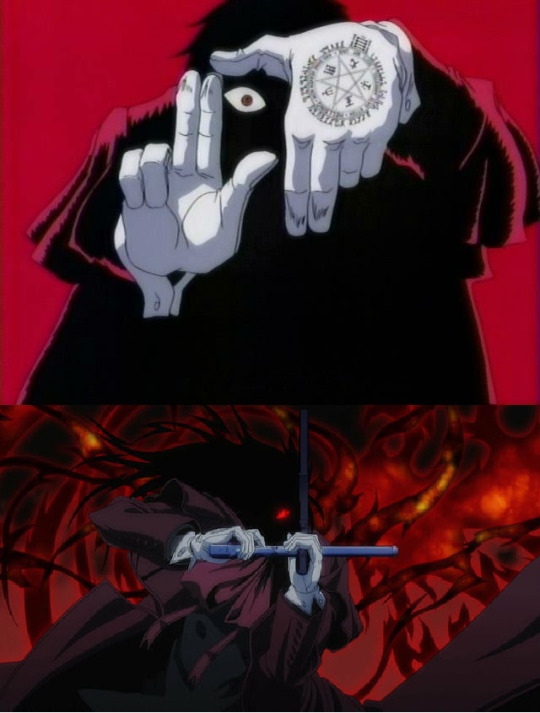
Speaking of his hands, let’s look at his gloves. Working from the outside in, we find Theban script, also known as the Witches’ Alphabet. Hirano’s Theban is poor, but we can make out enough to correct the script into what translates to “Hellsing”, “Hell’s Gate Arrested”, and “Shine Heaven Now”.

Closest to Alucard’s wrist, we see a number of 812. Knowing Hirano, this could just be a random number but I think the number refers to Gematria, a Jewish alphanumeric code that assigns numeric value to words and phrases, originally meant for the Torah. My favorite phrase I found that has a Gematric value of 812 is “Lucifer Begotten Son”, which would fall in line with the byname “Dracula” translating to “Son of the Dragon/Devil”.
And then we have the sigil, all placed within a circle. The sigil itself is reminiscent of those belonging to Goetic demons, found in the Ars Goetia, a section of “The Lesser Key of Solomon”. In the Ars Goetia, the Goetic demons images, descriptions, and sigils are displayed. For example, here is Astaroth’s sigil.

I think the way the sigil glows during the Cromwell Invocation means the sigil acts like a binding to Alucard as the sigils of the Goetic demons act to them.
The characters around the five-pointed star in Alucard’s sigil contain the alchemical symbols for Uranus and Neptune, representing the elements of Air and Water respectively, and stylized characters from other languages and cultures that represent the other three elements Fir, Earth, and Spirit.
And that’s all I can remember now, save for the references made in Stoker’s novel. I hope these are fun facts, because I have had fun picking up on them over the years.
126 notes
·
View notes
Text
Gremlin's Library
I'm still new to witchcraft and pagan religions, and know next to nothing about it outside my own personal views of magic and sacred. So my library right now is basically the result of me trying to learn about the different (and for now, more common) deities and paths I can take my craft and worship. I don't exactly know how good all those books are, but I'll read, learn and hopefully pave my own path on the way to explore the craft and my spirituality.
To Walk a Pagan Path: Practical Spirituality for Every Day - by Alaric Albertsson
The Poetic Edda: Stories of the Norse Gods and Heroes - Edited by Jackson Crawford
The Book of Hedge Druidry: A Complete Guide for the Solitary Seeker - by Joanna Van Der Hoeven
From the Cauldron Born: Exploring the Magic of Welsh Legend & Lore - by Kristoffer Hughes
The Book of Celtic Magic: Transformative Teachings from the Cauldron of Awen - by Kristoffer Hughes
The Path of Druidry: Walking the Ancient Green Way - by Penny Billington
Greek Mythology: A Concise Guide to Ancient Gods, Heroes, Beliefs and Myths of Greek Mythology - by Hourly History
Celtic Mythology: A Concise Guide to the Gods, Sagas and Beliefs - by Hourly History
Egyptian Mythology: A Concise Guide to the Ancient Gods and Beliefs of Egyptian Mythology - by Hourly History
Norse Mythology: A Concise Guide to Gods, Heroes, Sagas and Beliefs of Norse Mythology - by Hourly History
A Handbook of Saxon Sorcery & Magic: Wyrdworking, Rune Craft, Divination, and Wortcunning - by Alaric Albertsson
Collecting Rocks, Gems and Minerals: Identification, Values and Lapidary Uses - by Patti Polk
Traditional Witchcraft and the Pagan Revival: A Magical Anthropology - by Suzanne Ruthven
The Pagan Book of the Dead: Ancestral Visions of the Afterlife and Other Worlds - by Claude Lecouteux
The Big Book of Pagan Prayer and Ritual - by Ceisiwr Serith
A Pagan Ritual Prayer Book - by Ceisiwr Serith
Circle of the Sun: Rites and Celebrations for Egyptian Pagans and Kemetics - by Sharon LaBorde
The Witchcraft Collection Volume One: Dictionary of Satanism, Dictionary of Witchcraft, and Dictionary of Pagan Religions
Paganism: An Introduction to Earth-centered Religions - by Joyce Higginbotham and River Higginbotham
The Way of Fire and Ice: The Living Tradition of Norse Paganism - by Ryan Smith
Drawing Down the Moon - by Margot Adler
The Isles of the Many Gods: An A-Z of the Pagan Gods & Goddesses Worshipped in Ancient Britain During the First Millennium CE Through to the Middle Ages - by David Rankine and Sorita D'Este
The Herbal Alchemist's Handbook: A Complete Guide to Magickal Herbs and How to Use Them - by Karen Harrison
The Magick of Food: Rituals, Offerings & Why We Eat Together - by Gwion Raven
The Crooked Path: An Introduction to Traditional Witchcraft - by Kelden
The Element Encyclopedia of Witchcraft: The Complete A-Z for the Entire Magical World - by Judika Illes
The Witch's Book of Self-Care: Magical Ways to Pamper, Soothe, and Care for Your Body and Spirit - by Arin Murphy-Hiscock
Encyclopedia of Spirits: The Ultimate Guide to the Magic of Fairies, Genies, Demons, Ghosts, Gods & Goddesses - by Judika Illes
Sigil Witchery: A Witch's Guide to Crafting Magick Symbols - by Laura Tempest Zakroff
The Witch's Altar: The Craft, Lore & Magick of Sacred Space - by Jason Mankey and Laura Tempest Zakroff
The House Witch: Your Complete Guide to Creating a Magical Space with Rituals and Spells for Hearth and Home - by Arin Murphy-Hiscock
The Green Witch: Your Complete Guide to the Natural Magic of Herbs, Flowers, Essential Oils, and More - by Arin Murphy-Hiscock
Moon Spells: How to Use the Phases of the Moon to Get What You Want - by Diane Ahlquist
Llewellyn's Complete Book of Astrology: The Easy Way to Learn Astrology - by Kris Brandt Riske
Practical Candleburning Rituals - by Raymond Buckland
Encyclopedia of Ancient Deities - by Charles Russell Coulter
Osiris - by Bojana Mojsov
Magical Alphabets: The Secrets and Significance of Ancient Scripts Including Runes, Greek, Ogham, Hebrew and Alchemical Alphabets - by Nigel Pennick
Paganism Explained, Part I: Thrymskvida - by Marie Cachet and Varg Vikernes
Paganism Explained, Part II: Little Red Riding Hood & Jack and the Beanstalk - by Marie Cachet and Varg Vikernes
Paganism Explained, Part III: The Cult of Mithra & Hymiskvida - by Marie Cachet and Varg Vikernes
Paganism Explained, Part IV: Valholl & Odinn in Yggdrasill - by Marie Cachet and Varg Vikernes
Norse Magic and Asatru: An Essential Guide to Norse Divination, Elder Futhark Runes, Paganism, and Heathenry for Beginners -by Mari Silva
The Crystal Bible - by Judy Hall
(September 17, 2022)
Water Witchcraft: Magic and Lore from the Celtic Tradition - by Annwyn Avalon
The Spirit of the Celtic Gods and Goddesses: Their History, Magical Power, and Healing Energies - by Carl McColman
Fairies: A Guide to the Celtic Fair Folk - by Morgan Daimler
The Celtic Golden Dawn: An Original & Complete Curriculum of Druidical Study - by John Michael Greer
Wild Magic: Celtic Folk Traditions for the Solitary Practitioner - by Danu Forest
Mythology: A Captivating Guide to Greek Mythology, Egyptian Mythology and Norse Mythology - by Matt Clayton
The Mammoth Book of Celtic Myths and Legends - by Peter Berresford Ellis
The Morrigan: Celtic Goddess of Magick and Might - by Courtney Weber
Celtic Tales: Fairy Tales and Stories of Enchantment from Ireland, Scotland, Brittany, and Wales - by Kate Forrester
Celtic Myths and Legends - by T. W. Rolleston
Anam Cara - by John O'Donohue
Celtic Tree Magic: Ogham Lore and Druid Mysteries - by Danu Forest
Celtic Tree Rituals: Ceremonies for the Thirteen Moon Months and a Day - by Sharlyn Hidalgo
A Celtic Miscellany - by Kenneth H. Jackson
Brigid: History, Mystery, and Magick of the Celtic Goddess - by Courtney Weber
Tending Brigid's Flame: Awaken to the Celtic Goddess of Hearth, Temple, and Forge - by Lunaea Weatherstone
Tarot 101: Mastering the Art of Reading the Cards - by Huggens Kim
365 Tarot Spreads: Revealing the Magic in Each Day - by Sasha Graham
Practical Sigil Magic: Creating Personal Symbols for Success - by Frater U. D.
I'm pretty sure Z Library has all those books for free in a variety of formats for easy access (to those like me, that prefer reading a book before buying them).
#paganblr#baby witch#beginner witch#pagan#witchcraft#gremlin-post#witchblr#books#books and reading#witchy books#mythology books#books & libraries#book#book recommendations
89 notes
·
View notes
Text
Runic Divination: A Modern Invention
It is a popular belief (especially in certain Neo-Pagan and Heathen circles linked to Neo-Nazism and White Supremacy) that the runes of Elder Futhark:
Were the runes primarily used by the Vikings and represent a direct link to Viking ancestors
Have been used for divination for over a thousand years, representing a long and unbroken tradition, and that the way we use them now is the way the Norse used them in antiquity
Have ancient esoteric meanings that have remained unchanged through the passage of time
Unfortunately, none of these statements are true.
Around 98 AD, a Roman known as Publius Cornelius Tacitus wrote what was essentially an ethnological study of Germanic peoples entitled Germania. In Chapter X, he describes a system of divination used by one particular Germanic Tribe, an observation which later became the basis of what we consider today as runecasting and of the contemporary usage of Elder Futhark as an oracle:
"To divination and casting of lots, they pay attention beyond any other people. Their method of casting lots is a simple one: they cut a branch from a fruit-bearing tree and divide it into small pieces which they mark with certain distinctive signs and scatter at random onto a white cloth. Then, the priest of the community if the lots are consulted publicly, or the father of the family if it is done privately, after invoking the gods and with eyes raised to heaven, picks up three pieces, one at a time, and interprets them according to the signs previously marked upon them."
It is important to note that, at this time, the full inventory of the Elder Futhark alphabet was not yet finalized due to the fact that the sound inventory of Proto-Norse was not yet finalized. It wasn't until around 400 AD that all 24 runes can be solidly attested to within the archaelogical record. While it is probable that some letters of Elder Futhark were likely being used at the time Tacitus wrote his Germania, but it is extremely unlikely that the symbols carved upon the wooden tiles were Elder Futhark.
Additionally, there is simply no archaelogical or historical evidence beyond Tacitus' claims suggesting that the Proto-Norse or Norse used runes as a system of divination at all. Certainly the runes were used in magical contexts; there are many examples of runes and bindrunes being used as talismans and sigils inscribed on weapons, shields, jewelry etc. within the archaelogical record, but nothing suggests that these runes were ever used for divination as we know and use it today.
It is also important to note that Elder Futhark was not the alphabet used by the Vikings, as most proponents of runecasting claim; Elder Futhark was in use from the second century to the late 8th century (700s) in Scandinavia, when it was simplified to the Younger Futhark. The Younger Futhark WAS contemporaneous to the Vikings, and roughly corresponds to the Viking Age (793-1066 CE). This disproves the claim that the Elder Futhark is a direct link to Viking Ancestors -- the Vikings were using a different alphabet. It would be more accurate to say that the Elder Futhark runes linked the Vikings to THEIR Norse, Proto-Norse, and Germanic ancestors.
Finally, the meanings associated with the runes of Elder Futhark as we know them today were actually derived in modern times from the Norwegian, Icelandic, and Anglo-Saxon rune poems. None of these poems were written in Elder Futhark. The current theory proposed by modern linguists is that the Rune Poems were mnemonic devices used to help people remember the order, names, and, most importantly, the sounds of each letter of the alphabet. In other words, the Rune Poems were the equivalent to nursery rhymes.
With this new context, the use of nursery rhymes to assign esoteric meanings or properties to each rune seems a bit odd. Consider how silly it would be if, a thousand years from now, a group of people got a hold of one of those long posters found in elementary school classrooms meant to help children remember the order of the alphabet and decided that not only did the letter A definitively meant 'apple' and B definitively meant 'book', but that we as a society used these letters in order to divine the unknown.
Additionally, if the runes were preserving supposedly ancient meanings, we would expect these meanings to remain consistent throughout time with no variations. However, if the Rune Poems were instead preserving the phonetics associated with each runic letter by linking them to words beginning with that particular sound, we would see variation in the poems due to the linguistic variation of meaning.
And variation in meaning is exactly what we can observe between the Rune Poems; for example, the specific word linked to the phoneme represented in the stanzas attributed to Uruz talk about dross, a by-product of iron smelting within The Norwegian Rune Poem, about rain within The Icelandic Rune Poem, and then finally an aurochs in The Anglo-Saxon poem. The same can be observed for the stanzas attributed to Kenaz: the Norwegian and Icelandic rune poems refer to ulcers (likely derived from the Proto-Germanic *kaunan), while the Anglo Saxon refers to a torch (likely derived from Proto-Germanic *kenaz).
As an aside -- from examining the Rune Poems and comparing them to the commonly used modern meanings attributed to each rune, it is exceedingly obvious that whoever did assign said meanings primarily used The Anglo-Saxon poem as a jumping-off point.
In summary, Elder Futhark runes as we know them do not represent esoteric, magical concepts; the modern day meanings assigned to them were derived from translations of nursery rhymes meant to help people learn the Elder Futhark alphabet and, in some cases, were not the magical meanings ascribed to them by those who originally used them. Elder Futhark was not used by the Vikings and is not a direct link to Viking ancestors as many authors claim. Finally, there is no archaeological or historical evidence to suggest the runes were used for divination, nor was there a long and unbroken tradition of runecasting. The use of Elder Futhark as a tool of divination is a purely modern invention that dates back, at most, to the 1970's. The runes as they are used today are not 'ancient' nor is there a 'tradition' of using the runes for divination spanning back centuries, representative of an 'authentic and 'sacred' and 'holy' practice linked to Vikings.
As far as I can tell, Ralph Blum was the first one to write about the runes as a system of divination. Eddred Thorsson (Otherwise known as Stephen Flowers, who studied Runology, Germanic Languages, and Medieval Studies in an academic context), a known racist and white supremacist strongly linked to 'folkish' beliefs, Odinism, Asatru, and the Neo-Nazi Asatru Folk Assembly (a hate group recognised by the Southern Poverty Law Centre), expanded upon Blum's work and incorporated many Neo-Nazi beliefs based upon volkisch & Nazi doctrine, and is responsible for the perpetuation of these three myths (and quite a few others) into the present day with the publication of his books regarding runes. The publishing rights to Flowers/Thorsson's books are held by the Asatru Folk Assembly. Much of Flowers/Thorrson's assertions regarding the usage of runes is ultimately just unverified personal gnosis unsupported by archaeological or ethnographic evidence.
The association between runes and Nazism is certainly not new. The idea that the Germanic race (and its descendants) was superior to all others was central to Nazi ideology, and German ultranationalists scoured the archaelogical record to find proof of a link to a mythic 'Aryan' Heritage. They particularly liked the Armanen pseudo-Runes (the meanings of which miraculously were revealed to a man named Guido von List in 1902 after suffering temporary blindness following cataract surgery), but ultimately they shifted their attention to the appropriation of the runes of the Elder Futhark. The most infamous rune used by the Nazis is Sowilo, the 's' rune representing the sun, which was renamed the 'Siegrune' (Victory rune) and was used as a symbol for Hitler's Schutzstaffel (ie. The SS). Other runes that were misappropriated include Othala (inheritance) which was used as a symbol for the mantra 'Blud und Boten' (Blood and Soul), and Tiwaz (Tyr), which became a symbol for war and struggle. To claim that the runes represent a long-standing tradition and link to 'the ancestors' is straight up Nazi rhetoric.
This doesn't make the runes any less useful as an oracle! Oracles and divination help us find meaning in our lives as well as help us explain the universe around us, especially when we're faced with the murky unknown or with things that cannot otherwise be explained by other models or paradigms of rationalization. Using the runes to seek out answers to otherwise 'unknowable' questions is actually a method of reframing and recontextualizing our experiences via the viewpoint of an objective outsider, providing new insight and promoting introspection. This is especially helpful if what we 'learn' might not be things we want to hear or think about, especially concerning ourselves. It also helps us elevate the subconscious into the conscious, and makes us aware of things we didn't otherwise give much thought to due to our tunnel-vision view and tendency to focus only on the things we think are important or relevant.
The lesson to be learned from this is that it is important to critically examine so called 'traditions', especially ones claiming to be ancient and representative of 'ancestral' practices -- oftentimes the people perpetuating such beliefs have done so for a reason. Unfortunately, because Flowers/Thorsson's work is so prevalent within the pagan community, and because so many sources regarding runic divination end up linking back to his work, the practice of runecasting and using runes for divination has become tainted with Nazi rhetoric. It is for this reason that I am highly critical of any source listing the 'meanings' of the runes.
So… what can you do about this? Don't buy Flowers/Thorrson's books, obviously. Be critical of all sources when researching runes. Evaluate whether or not this person did their own research, or simply took Flowers/Thorrson's work at face value. Laugh openly at anyone who practices Rune Yoga.
My recommendation to rune enthusiasts is to study the Rune Poems and research the etymology of each rune word and come up with your own meanings and extensions, just like you would when researching the meaning of tarot cards. By doing this, you'll probably also find that you feel even more connected to them than before.
And, above all else, make your space an unsafe space for Nazis.
ᚠᚢᚲ ᚾᚨᛉᛁᛊ
References:
Andersen, Harry. "Three Controversial Runes in the Older Futhark (2)". North-Western Language Evolution, vol. 4, no. 5, 1985, pp. 3-22.
Antonsen, Elmer H. "The Proto-Norse System and the Younger Futhark". Scandinavian Studies, vol. 35, No. 3, 1963, pp. 195-207.
Dickins, Bruce. Runic and Heroic Poems of the Old Teutonic Peoples. Cambridge University, 1915.
Hoppadietz, Ralf, and Reichenbach, Karin. "In Honor of the Forefathers: Archaelogical Reenactment between History Appropriation and an Ideological Mission. The Case of Ulfhednar." Reenactment Case Studies: Global Perspectives on Experiential History, edited by Vanessa Agnew, Sabine Stach, and Juliane Tomann. Routledge, 2023.
Imer, Lisbeth. "How the Nazis abused the history of runes." ScienceNordic. 13 October 2018. Translated by Frederik Appel Olsen. https://sciencenordic.com/denmark-forskerzonen-history/how-the-nazis-abused-the-history-of-runes/1459227. Accessed 28 January 2023.
Knirk, James E. "Runes: Origin, development of the furthark, functions, applications, and methodological considerations." The Nordic Languages, vol. 1, 2002, pp. 634-648.
Southern Poverty Law Center. "Asatru Folk Assembly." SPLC: Southern Poverty Law Center. https://www.splcenter.org/fighting-hate/extremist-files/group/asatru-folk-assembly. Accessed 28 January 2023.
Southern Poverty Law Center. "Neo-Völkisch." SPLC: Southern Poverty Law Center. https://www.splcenter.org/fighting-hate/extremist-files/ideology/neo-volkisch. Accessed 28 January 2023.
Tacitus, Cornelius Publius. Germania. AD 98. Translated by Alfred John Church and William Jackson Brodribb, Macmillan & Co., 1869.
#runes#runecasting#norse paganism#elder futhark#norse#witchcraft#witchblr#vikings#local queer goose here to set the record straight#fuck nazis
32 notes
·
View notes
Text
Witchcraft "Lesson Plan" Part 3
More info on this plan and how to use it here
Part 1
Part 2
Below the cut you will find:
XII Ritual Tools
XIII Basic Ritual Magic
XIV Types of Magic: attracting and repelling magic
XV Types of Magic: Ceremonial magic and Talisman magic
XVI Types of magic: Sympathetic magic and Nature magic
XVII Types of Magic: Divination Magic
XVIII Types of Magic: Beyond the Basics
XII Ritual Tools
the What, why, who, where, and when of ritual tools
Primary Tools: athame, book of shadows, wand, chalice, and pentacle
Secondary Tools: boline, broom, cauldron, cords, staff, sword
Other tools: incense holder, the scourge, sickle, elemental and deity representations, etc.
Keeping and taking care of tools
Psychodrama
XIII Basic Ritual Magic
the three C’s: Cleansing, Consecrating, and Charging
Spiritual Self-defense
Basic Spellcraft (writing your own spells)
Magical alphabets
Trancework
Personal deity vs. deity for a specific goal
XIV Types of Magic: attracting and repelling magic
What is attracting magic?
What is repelling magic?
Different types and examples
Important works/influences
How to perform an effective attracting of repelling spell
Healing magic: details and techniques
XV Types of Magic: Ceremonial magic and Talisman magic
History of Ceremonial magic
Important works/influences
Basics of Ceremonial magic
History of Talisman magic
Talisman vs. Amulet
Sigils and Bindrunes
How to make a talisman or amulet
XVI Types of magic: Sympathetic magic and Nature magic
Herbal magic
Crystal magic
Tree magic
Weather- and seasonal magic
Sun- and Moon magic
cycles of the day/ the year/ the moon/ astrology
Planetary magic and correspondences
Animal magic
Color magic
Candle magic
Ley lines and places of power
Alchemy
Astrology
Poppet magic
Using blood in ritual
XVII Types of Magic: Divination Magic
Tarot and Oracle Cards
Runes
Pendulums and dowsing
Scrying
Ouija- and Spiritboards
Palmreading
Numerology
XVIII Types of Magic: Beyond the Basics
Astral Travel
Shapeshifting
Aspecting Deity (deity possession)
Using fiction in Ritual
Pop-culture magic
Mental rituals/temples
Techno- and Cybermagic
Traditional magic
Art magic
40 notes
·
View notes
Note
cool, an unown specialty shelter! interrobang is a pretty cool variant already, but what's the most out-there unown you've seen? kalosian accented? kanji? wingdings?
-(@feraligatrfangs)
Ah! A fellow excited enthusiast, I infer? Or perhaps at least I hope?
Well, it is known that Unown are weak as individuals, yes. But there are subcategories of Unown only barely filtering into our reach that hold more meaning than a single symbol! The most minor variation we have seen are accented anomalies, which are only a bit more capable on their own, followed by other basic alphabets. Then we get to the really juicy stuff with punctuation peeps beyond ! and ?, like Interrobang, or this ellipses-alike we have recently recovered! But currently, the most powerful we have seen are what we are referring to as Sigil Class! This is where kanji comes in, as well as other symbols that can read as a full word! They are worth a whole dedicated deep dive discussion, so I'll cut this short and say if you ever see one that looks like the kanji for sound, cover your arc damn ears!
9 notes
·
View notes
Text
The nights of hours of research I did for different aspects of the manga was normal and not obsessive teehee.
Yes I tried to manually manually find the ancient nordic language that marcille wrote for dark magic spell( I tried typing my process for 10 mins but I know I’ll end up making it too long to write) but basically I believe it was different randomly selected letters that was picked from different ancient Swedish alphabets as references to draw the magic text .since also I’m not a professional language person so I had to give it up and realize I was way out my league. The Dante’s inferno moment with senshi. The bug classification research for succubus/incubus and wasp shown in the beginning of manga. Incubus bug is Asian giant hornet. The tower that marcille makes is a reference for prisoners torture back then I believe for traitors. Lion is Buer Demon. Izu and other half animal humanoids that are formed from Posession is inspired from one of the type of animal Jinns. When I tried to make a compiled timeline of all the events that is given in the meshi bible. I regret doing reasearch for Laius name tho . The events of the depths coinciding with levels of hell was craziest. Trying to find meaning for sigils/signs for staffs. Utaya puzzle pieces. I can’t remember what else but I know I’m prolly forgetting something from years ago. I think I did all that cause of hiatus months. The rose of Versailles reference. I know I did chimera research but I don’t remember if it was importante. I think I did all that cause of hiatus months tralala . If you read all of this forget it neow
5 notes
·
View notes
Text
SFW Alphabet Elia Martell
Elia Martell x GN Reader
Affection: Elia is slightly more reserved in public. As regent for her son Aegon Elia must be the epitome of decorum. However, she does not abstain from physical comfort entirely. She likes to sometimes hold your hand or put a hand on the small of your back. Sometimes she feels a bit naughty and sneaks a kiss😉
In private it's a different story. Expect lots of affection including cuddling and kisses. She enjoys touching, not necessarily in a sexual way (though it is appreciated), but it helps ground her. It reminds her your are real.
Best friend: Well your relationship has by now reached beyond the platonic stage. Elia enjoys a partner who can is funny and can keep up with her wit. Empathy is also greatly appreciated, she definitely needs it. Don't think this is one-sided, Elia will absolutely return the favor.
Cuddles: Elia enjoys having her head on your chest. If you have breasts then she might choose to lay on your stomach instead. Expect very long cuddle sessions after council meetings.
Domestic: Elia definitely is all for that family life. She already has two kids by Ratgar Rhaegar, and you as her loving partner! If you have kids she is more than happy to accept them. Because of her family life at home expect her to be very involved. Even though she has her duties, Elia likes to take breakfast with the family and a walk in the park. At night it's time for just the two of you. If sex is not on the menu then Elia might dedicate her time to reading or sewing.
Ending (how would they end it): Absolutely not. Only fluff aloud here.
Fiancé (how quick are they to commit to a relationship): After what happened with Rhaegar, Elia had closed off her heart. It was only after years of knowing you that was she ready. Before Rhaegar Elia was quick to fall in love. Afterward, it is much harder. Once she does fall in love with you expect utter devotion.
Gentle (how gentle are they): Very gentle both physically and emotionally. She wouldn't want to hurt you.
Hugs: Yes yes yes
I love you: I see Elia saying it after the first time you two have sex. For Elia this is the ultimate show of the bond you two share. At this point, you two have known each other for several years. So it takes some time.
Jealousy: Elia has her scars from Rhaegar. Unfortunately, this subconsciously makes her feel insecure at times. So it's less like possessive jealousy and more Elia afraid to lose you. Happily, Elia's wounds will lessen and soon she knows no one can replace her in your heart. As the years go by Elia is not bothered by those who seek your attention. They can not compete with her anyway. She is yours and you are hers.
Kisses: There are two kinds of kisses Elia likes to give. Deep, slow sensual kisses. She kisses to take her time with these. If she feels a little more playful Elia likes to give ticklish kisses across your body, your giggles are so cute!
Little ones (how are they around children): Elia loves kids. Elia would probably adopt every child in Flee Bottom if she could get away with it. One of Elia's joys is raising kids right along with you.
Mornings: Elia has her responsibilities. That being said she will snuggle with you for a bit and eat. On mornings were she has nothing to do Elia likes to take a nice long bath with you.
Nights: She likes to lie on the big fur blanket by the fireplace. That carpet has witnessed many activities (like you reading Elia books, perves).
Open (how open is Elia): This depends if you were with her while she was a princess. If yes then she is much more open because you stayed with her during the worst. If not then it will take a while, maybe a few years.
Patients: This lady has dealt with Oberyn, Aery,s and Rhaegar. Its very rare.
Quizzes (how much do they remember about you?): Elia has a very good memory and is super attentive.
Remember(favorite memory): The day you pledged yourself to her. Making a cape with the sigil of your house you draped it over Elia's shoulders in the sept. It was a private moment, only witnessed by the gods themselves.
Security (how protective are they): Do. Not. Mess. With. Elia. She is a Martell and Princess Regent of the seven Kingdoms. So good luck to anyone who might harm you. While no Oberyn, Elia is just as protective. She will go to any lengths to protect you.
Try (how hard do they try): The two of you like to do things on a smaller, more intimate scale. She knows what you like and has a keen memory. So long as it makes you happy she will do it. So yes, Elia puts a lot of effort into making you happy.
Ugly: Insecurity. Elia's marriage was extremely traumatizing. This meant that for the first few years of her widowhood Elia wasn't sure if your affections were real. It almost caused the two of you to separate. Luckily, Elia had a long conversation with Oberyn followed by a break. The two of you mended your relationship and happily live together. Even though Elia still struggles, she works hard to get better.
Vanity: Of course, she has to look lovely, Elia is the Kings mother after all. I would say she has a healthy reflection with her looks these days. After Robert's Rebellion Elia did find herself unattractive for a while but realized Rhaegar is stupid.
Whole (how would they feel without you): A bit of you would always have her. If you ever left I think Elia would lose a piece of herself.
Xtra (random info): Likes to randomly paint nails. She and Oberyn use to prank Doran Martell. The Oberyn Martell had daughters and Elia painted their nails. These days Elia will find herself finding the urge to paint something. And yes, you have woken to find your toenails painted.
Yuck (what grosses them out): pickles
Zzz(sleep habits): Elia goes to bed late and wakes up early. Perks of being Princess Regent.
#elia martell#pro elia martell#dorne#martell#house martell#elia martell deserves better#elia martell x reader#elia martell sun of dorne
20 notes
·
View notes